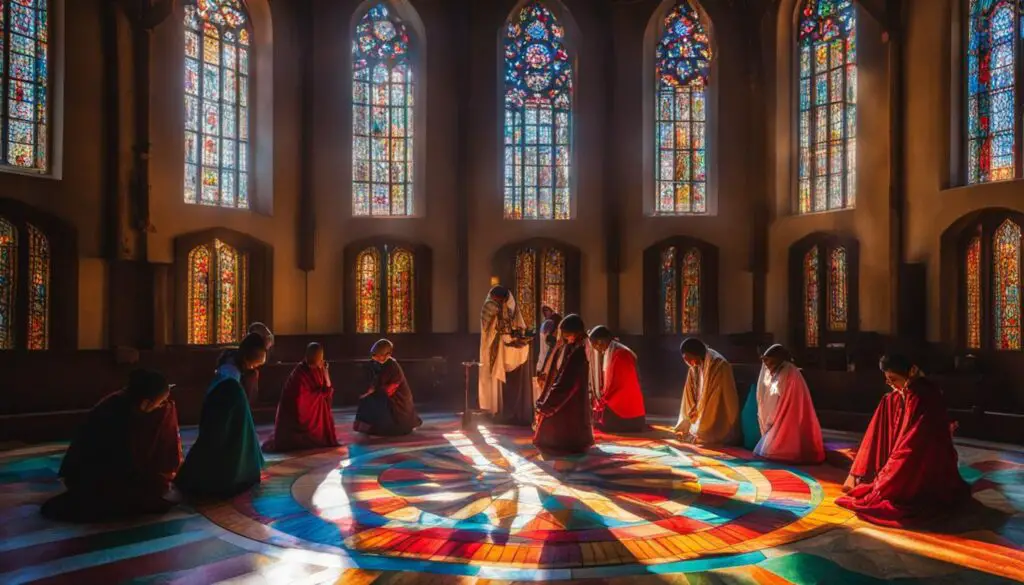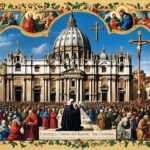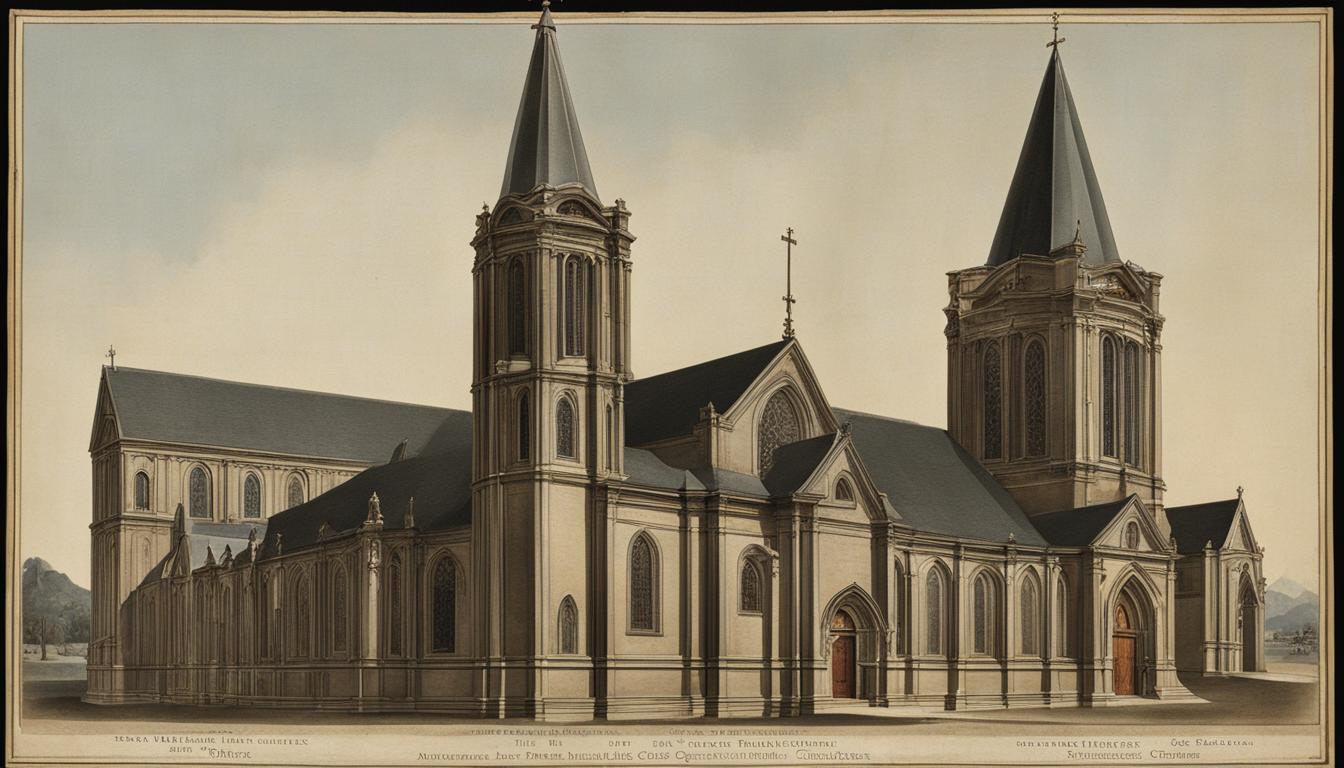Welcome to our exploration of the rich history and origins of the Congregational Church. This Protestant denomination has played a significant role in shaping the religious landscape of the United States. Let’s delve into the fascinating journey of how it all began.
The Congregational Church emerged in the 16th and 17th centuries as a movement within the Church of England. Seeking to purify the church of Catholic practices, a group of passionate individuals set out to create a place of worship rooted in their own beliefs and values.
Central to the origins of the Congregational Church was the concept of individual autonomy. Each congregation governs its own affairs, allowing for a dynamic and democratic system where decisions are made by the collective voices of its members.
Key Takeaways:
- The Congregational Church originated in England as a movement within the Church of England.
- It emerged in the 16th and 17th centuries with a focus on purifying the church and emphasizing the autonomy of each congregation.
- Individual congregations have the freedom to govern their own affairs.
Beliefs and Doctrines of the Congregational Church
The Congregational Church is rooted in Calvinist theology and holds to the sovereignty of God. They emphasize the priesthood of all believers, the authority of the Bible as the word of God, and salvation through faith in Jesus Christ. Congregationalists believe in the importance of personal conversion and the need for individuals to have a personal relationship with God. They also value social justice, community engagement, and the pursuit of truth.
In the Congregational Church, beliefs and doctrines are centered on the core principles of Calvinism. Congregationalists affirm the sovereignty of God, believing that God has complete control over all creation and that salvation is a divine work of grace. They believe in predestination, the idea that God has chosen certain individuals for salvation, and that nothing can change His eternal plan.
One of the key beliefs of the Congregational Church is the doctrine of the priesthood of all believers. This means that every member of the church has direct access to God and is responsible for their own spiritual journey. Congregationalists value the autonomy of the individual conscience and encourage each person to study and interpret the Bible for themselves, guided by the Holy Spirit.
The authority of the Bible is central to the beliefs of the Congregational Church. They view the Bible as the inspired word of God and the ultimate source of truth and guidance. Congregationalists study and teach the Bible, seeking to understand its meaning and apply it to their lives. They believe that the Bible contains everything necessary for faith and practice.
Salvation through faith in Jesus Christ is a fundamental belief of the Congregational Church. Congregationalists affirm that Jesus is the Son of God, the Savior of mankind, and the only way to eternal life. They emphasize the need for personal conversion, where individuals confess their sins, repent, and place their faith in Jesus Christ as their Lord and Savior.
Alongside these core beliefs, the Congregational Church also places a strong emphasis on social justice and community engagement. Congregationalists believe in the importance of loving their neighbors and working towards a more just and equitable society. They seek to alleviate poverty, fight for human rights, promote equality, and address systemic injustices.
The Congregational Church’s Beliefs and Doctrines at a Glance:
| Beliefs | Doctrines |
|---|---|
| Calvinism and the sovereignty of God | The priesthood of all believers |
| The authority of the Bible | Salvation through faith in Jesus Christ |
| Personal conversion and a personal relationship with God | Social justice and community engagement |

Sacraments and Rituals in the Congregational Church
The Congregational Church practices two sacraments: baptism and the Lord’s Supper. These sacraments hold deep spiritual significance for believers in the Congregational tradition.
Baptism: Baptism is a symbolic act that represents a person’s initiation into the community of faith. It is a public declaration of one’s commitment to Christ and the Congregational Church. Through baptism, individuals are symbolically cleansed of their sins and welcomed into the fellowship of believers.
The Lord’s Supper: Also known as communion or the Eucharist, the Lord’s Supper is a central ritual in the Congregational Church. It serves as a memorial of Christ’s sacrifice on the cross and a time of spiritual nourishment for believers. During this solemn ceremony, congregants partake of bread and wine (or grape juice) as a symbol of the body and blood of Jesus Christ. It is a moment of reflection, gratitude, and renewed commitment to following Christ’s example.
“Just as Jesus shared the Last Supper with his disciples, the Congregational Church continues to participate in this sacred ritual, connecting believers across generations and reaffirming their faith.”
Importance of Sacraments and Rituals
The sacraments of baptism and the Lord’s Supper play a significant role in the spiritual life of Congregationalists. While these rituals are not considered essential for salvation in the Congregational Church, they serve as powerful reminders of the grace, love, and sacrifice of Jesus Christ.
Comparing Baptism and the Lord’s Supper
| Baptism | The Lord’s Supper |
|---|---|
| Serves as initiation into the community of faith | Remembers the sacrifice of Christ on the cross |
| Symbolizes the cleansing of sins | Symbolizes nourishment and spiritual sustenance |
| Typically administered once during a person’s lifetime | Often observed regularly as part of worship services |
| Emphasizes individual commitment to Christ | Reaffirms collective unity as the body of Christ |
The sacraments and rituals of the Congregational Church serve to strengthen the faith of believers, deepen their connection to God, and foster a sense of unity within the congregation. Through these sacred practices, congregants are reminded of their shared beliefs and the enduring presence of God in their lives.
Leadership and Clergy in the Congregational Church
The Congregational Church operates on a system of congregationalist polity, emphasizing the autonomy of each local congregation. Within this structure, leadership roles are filled by elected or appointed laypeople, including pastors, elders, and deacons. These individuals play a crucial role in providing spiritual guidance and leadership to the congregation.
The clergy in the Congregational Church are tasked with shepherding and equipping the congregation, nurturing their faith, and assisting in their spiritual growth. They are passionate about their calling and dedicated to serving and ministering to the needs of the church community.
While the clergy provide guidance and leadership, the ultimate decision-making authority rests with the congregation as a whole. This participatory approach reflects the Congregational Church’s commitment to the priesthood of all believers and the importance of collective discernment in shaping the direction of the church.
The Congregational Church recognizes that leadership is not confined to a select few but rather extends to all members who are called to use their unique gifts and talents for the benefit of the church and its mission. This collaborative and inclusive approach to leadership creates a vibrant and engaged congregation, with each individual contributing to the growth and vitality of the church.
Key Roles in Congregational Church Leadership
- Pastors: Pastors serve as spiritual leaders of the congregation, providing preaching, teaching, and pastoral care. They have an integral role in guiding the church’s worship and facilitating its spiritual growth.
- Elders: Elders are responsible for the spiritual oversight of the congregation. They provide wisdom, counsel, and leadership, ensuring the church remains faithful to its mission and values.
- Deacons: Deacons focus on the practical needs and welfare of the congregation and wider community. They serve and support the congregation through acts of compassion, assistance, and service.
The Congregational Church recognizes that leadership is not limited to these specific roles but can manifest in various ways within the congregation. Each member has the opportunity to contribute their unique strengths and gifts, creating a diverse and vibrant leadership landscape.

“Leadership is not about the title or position; it’s about serving and empowering others to grow and thrive.”
Worship Practices in the Congregational Church
Worship in the Congregational Church is a deeply meaningful and sacred experience. Congregationalists approach worship with simplicity, reverence, and a desire to honor God. Through a combination of hymns, prayers, and biblical readings, worshippers engage in a spiritual journey that strengthens their faith and deepens their connection with the divine.
The centerpiece of worship in the Congregational Church is the sermon. Pastors deliver powerful messages rooted in scripture, offering guidance, inspiration, and a deeper understanding of God’s word. These sermons not only provide intellectual insights but also touch the hearts and souls of the congregation, provoking introspection and personal growth.
One of the unique aspects of worship in the Congregational Church is its emphasis on congregational participation. While the pastor may lead the service, the congregation actively engages in various worship elements, such as singing hymns together, reciting prayers, and participating in responsive readings. This active participation creates a sense of unity and community, where everyone’s voice is heard and valued.

The style of worship may vary from one Congregational Church to another. Some may follow a more traditional format, while others embrace a contemporary approach. Regardless of the style, the focus remains on seeking a genuine encounter with God, cultivating a personal relationship, and offering heartfelt expressions of devotion.
In addition to the regular worship services, the Congregational Church also celebrates special occasions and seasons throughout the year. These may include Advent and Christmas services, Lenten reflections, Easter celebrations, and other significant events in the Christian calendar. These moments provide opportunities for worshippers to connect with the broader narrative of the faith and reflect on its profound significance.
Worship in the Congregational Church is a sacred time of devotion, reflection, and spiritual growth. It is a collective journey of faith and a profound experience of encountering the divine presence. Through worship, Congregationalists honor their beliefs, nurture their relationship with God, and draw strength from the rich traditions of their congregation.
Sacred Texts in the Congregational Church
In the Congregational Church, the Bible is revered as the primary sacred text, regarded as the inspired word of God. The congregation holds firmly to the belief that scripture has the authority and relevance to guide their beliefs and practices. Although there is no specific translation or version of the Bible that is mandated for use, Congregationalists commonly reference various translations such as the King James Version, the New International Version, and the English Standard Version.

The Authority of Scripture
Within the Congregational Church, the Bible holds a position of utmost importance. It serves as a cornerstone for understanding God’s will, providing guidance and wisdom for daily life. Congregationalists view the Bible as the ultimate source of truth and draw upon its teachings to shape their beliefs and practices.
“The sacred text of the Bible not only informs our faith, but it also serves as a compass, guiding us through the challenges and complexities of life. Its timeless truths resonate with us, revealing God’s character and inviting us into a deeper relationship with Him.”
Interpretation and Application
While the Bible is revered as the inspired word of God, Congregationalists also recognize the need for diligent study and interpretation. They value the role of pastors, theologians, and the community in collectively discerning the meaning and application of scripture in their contemporary context.
A Dynamic and Living Word
Congregationalists view the Bible as a dynamic and living text that continues to speak to believers today. Its stories, teachings, and lessons from the past offer timeless insights and wisdom that are relevant in the modern world. The Bible’s transformative power is believed to guide individuals on their spiritual journey and inspire them to live out their faith in practical ways.
Denominations and Sects within the Congregational Church
The Congregational Church encompasses a variety of denominations and sects, each with its own unique beliefs and practices. While all of these groups share common roots in the Congregationalist tradition, they may have different interpretations of certain theological issues and varying levels of organizational structure.
Some of the denominations and sects within the Congregational Church include:
- United Church of Christ
- National Association of Congregational Christian Churches
- Conservative Congregational Christian Conference
“We may have different interpretations of certain theological issues and varying levels of organizational structure, but we are all united in our common roots within the Congregationalist tradition.”
Each of these denominations and sects represents a unique expression of faith within the larger Congregational Church. They may have their own distinctive doctrines, worship practices, and approaches to leadership and governance.
It is important to note that while there are differences among these denominations and sects, they all share a commitment to the principles and values of the Congregationalist tradition. They are united in their belief in the autonomy of local congregations, the authority of the Bible, and the importance of personal faith and relationship with God.
Comparison of Denominations and Sects within the Congregational Church
| Denomination/Sect | Beliefs | Worship Practices | Leadership and Governance |
|---|---|---|---|
| United Church of Christ | Emphasis on inclusivity and social justice | Varies, but often includes traditional liturgical elements | Combination of ordained and lay leadership, congregational polity |
| National Association of Congregational Christian Churches | Emphasis on local autonomy and congregational polity | Varies, but often includes a blend of traditional and contemporary worship styles | Combination of ordained and lay leadership, congregational polity |
| Conservative Congregational Christian Conference | Emphasis on biblical authority and conservative theology | Varies, but often includes traditional hymns and liturgical elements | Ordained leadership, congregational polity |
While this table provides a brief overview of some of the differences among these denominations and sects, it is important to remember that each congregation within a specific denomination or sect may have its own unique practices and beliefs.

Community and Outreach in the Congregational Church
The Congregational Church places a strong emphasis on community and outreach, embodying the teachings of Christ through acts of service and compassion. Congregations actively engage in various community service projects, extending a helping hand to those who are hungry, vulnerable, or in need. Their commitment to serving others is a reflection of their faith and a tangible way of demonstrating God’s love.
Through initiatives like food drives, homeless shelters, and educational programs, Congregational churches reach out to their local communities, addressing social issues and providing support to those facing hardship. They strive to make a positive impact and create a sense of belonging among individuals from all walks of life.
To foster a sense of fellowship and community among its members, the church organizes regular gatherings, small groups, and social events. These opportunities for connection and shared experience enable individuals to build meaningful relationships, find support, and grow in their faith journey together.
Moreover, the Congregational Church is deeply committed to mission work, both locally and internationally. Through these missions, members actively participate in spreading the love of Christ by offering aid, assistance, and spiritual guidance to those in need. By reaching beyond the boundaries of their own congregation, they exemplify the values of compassion and inclusivity.
Congregational Church’s Commitment to Community
“The heart of the Congregational Church beats for the community. We strive to make a positive difference in the lives of those we serve, supporting and uplifting individuals through acts of love and kindness.” – Reverend Sarah Miller.
Examples of Outreach Activities
- Tutoring programs for students in underprivileged communities.
- Food banks and soup kitchens to feed the hungry.
- Support groups for individuals struggling with addiction or mental health issues.
- Partnerships with local organizations to provide shelter for the homeless.
Mission Work
Mission work is a fundamental part of the Congregational Church’s commitment to spreading the love of Christ. Through international partnerships, Congregationalists engage in projects such as building schools, medical missions, and disaster relief efforts, providing both physical and spiritual assistance to communities in need.
Furthermore, local mission work involves engaging with marginalized populations and addressing social injustices within their own communities. By actively participating in these missions, Congregationalists seek to transform lives and bring hope to those who have been marginalized or forgotten.
Architectural and Artistic Features of Congregational Churches
Congregational churches feature a diverse array of architectural styles, ranging from the classic steepled buildings to contemporary designs. While simplicity and functionality are often prioritized in their construction, many congregational churches also showcase intricate artistic features that enhance the worship experience.
One notable architectural feature commonly found in congregational churches is the use of ornate stained glass windows. These beautiful works of art depict biblical scenes, religious symbols, and saints, allowing natural light to filter through and create a sublime ambiance within the sacred space.
Additionally, congregational churches often incorporate exquisite woodwork into their interior design. From intricately carved pews and pulpits to detailed paneling and arches, these artistic elements showcase skilled craftsmanship and add a touch of elegance to the worship environment.
The use of organs is another architectural feature that holds significance in congregational churches. These majestic instruments serve as both a functional means of accompanying hymns and a symbol of musical worship. With their towering pipes and resounding tones, organs enrich the auditory experience and amplify the sense of awe and reverence during services.
“The architectural and artistic features of congregational churches create an atmosphere that inspires a deep sense of wonder, beauty, and spiritual connection.”
Artworks such as paintings and sculptures are also often found within congregational churches. These pieces of art depict biblical narratives, religious figures, and scenes of devotion, enriching the visual aesthetics and spiritually engaging the worshippers.
Sacred Spaces and Splendor
Congregational churches are not only places of worship but also works of art in themselves. The architectural and artistic features of these churches contribute to the overall sense of reverence, tranquility, and splendor that individuals and communities experience during religious gatherings.
| Architectural Features | Artistic Features |
|---|---|
| Steepled buildings | Ornate stained glass windows |
| Woodwork details, such as carved pews and paneling | Paintings depicting biblical scenes |
| Elaborate organ systems | Sculptures of religious figures |
The combination of these architectural and artistic features creates an atmosphere that inspires a deep sense of wonder, beauty, and spiritual connection. Whether through the awe-inspiring stained glass windows, the intricate woodwork, or the harmonious sounds of the organ, these elements invite worshippers to engage their senses and immerse themselves in the spiritual journey.
As congregational churches continue to evolve and adapt to modern times, they remain rooted in the appreciation of architectural and artistic craftsmanship that enhances the worship experience and fosters a deeper connection with God.
Contemporary Issues and Challenges in the Congregational Church
Like any religious organization, the Congregational Church faces a variety of contemporary issues and challenges. In the fast-paced and ever-changing world we live in, the church must navigate through complex discussions around social and political issues, striving to find a balance between staying true to their beliefs and engaging with the world around them.
One of the challenges the Congregational Church faces is addressing changing cultural norms and attitudes. As society evolves and new perspectives emerge, the church must grapple with how to interpret and apply their long-standing doctrines and principles. It is vital to foster an environment of understanding and dialogue within congregations, where differing opinions can be heard and respected.
Technological advancements also present challenges for the Congregational Church. With the rise of digital communication and social media, churches must adapt their outreach and communication strategies to remain relevant and engage with the wider community. Embracing technology offers opportunities for sharing their message and connecting with individuals who may not traditionally attend church.
On an individual congregation level, challenges may include membership decline and financial sustainability. In an increasingly secular society, attracting and retaining members can be a struggle. Churches must find innovative ways to meet the evolving spiritual needs of their congregants and create a sense of belonging and community. Additionally, managing financial resources effectively becomes crucial to ensure the long-term viability of the church and its mission.
Despite these challenges, the Congregational Church has a rich history of resilience and adaptability. By embracing their core values and engaging with contemporary issues in a thoughtful and compassionate manner, they have the opportunity to influence and contribute positively to the communities they serve.
| Contemporary Issues | Challenges |
|---|---|
| Navigating discussions around social and political issues | Membership decline |
| Addressing changing cultural norms and attitudes | Financial sustainability |
| Adapting to technological advancements in communication and outreach | Maintaining relevance and connection within local communities |
It is through their commitment to navigating these challenges that the Congregational Church can continue to grow and evolve, remaining a relevant and transformative force in the lives of its members and the wider world.
Conclusion
The Congregational Church holds a rich history and continues to be a significant presence in the religious landscape of the United States. Its origins can be traced back to the 16th and 17th centuries in England when it emerged as a movement seeking to purify the Church of England. Throughout the years, the Congregational Church has placed a strong emphasis on individual autonomy, community engagement, and nurturing a personal relationship with God, deeply influencing the lives of millions of believers.
Despite the challenges faced by the modern Congregational Church, its commitment to the core values of faith, community, and service remains unwavering. Congregationalists hold firm to their beliefs and doctrines, rooted in Calvinist theology and a deep reverence for the Bible as the inspired word of God. The church practices sacraments such as baptism and the Lord’s Supper, valuing their symbolic importance in spiritual growth and communal worship.
Leadership within the Congregational Church is primarily carried out by elected or appointed laypeople, who guide the congregation in spiritual matters while honoring the autonomy of each individual church. Worship practices in Congregational churches are characterized by simplicity, with a focus on hymns, prayers, biblical readings, and sermons that aim to provide guidance and inspiration. Congregationalists also actively engage in community outreach and service, embodying their core value of social justice and serving those in need.
With its diverse denominations and sects, the Congregational Church expresses its faith in various architectural styles, exhibiting both simplicity and beauty. While facing contemporary challenges, such as navigating societal shifts and addressing declining membership, the Congregational Church continues to adapt and remains committed to its enduring mission of faith, community, and service.
FAQ
What is the history of the Congregational Church?
The Congregational Church is a Protestant denomination that originated in England in the 16th and 17th centuries as a movement within the Church of England. It sought to purify the Church of England of Catholic practices and became known for its emphasis on the autonomy of each individual congregation.
What are the beliefs and doctrines of the Congregational Church?
The Congregational Church is rooted in Calvinist theology and emphasizes the sovereignty of God, the authority of the Bible as the word of God, and salvation through faith in Jesus Christ. Congregationalists believe in the importance of personal conversion and the need for individuals to have a personal relationship with God. They also value social justice, community engagement, and the pursuit of truth.
What sacraments and rituals are practiced in the Congregational Church?
The Congregational Church practices two sacraments: baptism and the Lord’s Supper. Baptism is a symbolic act that signifies a person’s initiation into the community of faith. The Lord’s Supper, also known as communion or the Eucharist, is a memorial of Christ’s sacrifice on the cross and a time of spiritual nourishment for believers.
How is leadership and clergy structured in the Congregational Church?
The Congregational Church operates on a system of congregationalist polity, where each local congregation is autonomous and governs itself. Leadership roles, such as pastors, elders, and deacons, are typically filled by elected or appointed laypeople. The clergy provide spiritual guidance and leadership, but ultimate decision-making authority rests with the congregation.
What are the worship practices in the Congregational Church?
Worship in the Congregational Church is characterized by simplicity and reverence. It includes hymns, prayers, and biblical readings. Sermons play a central role, with pastors delivering messages rooted in scripture. The style of worship may vary, but the focus is always on honoring God and seeking a deeper connection with Him.
What are the sacred texts of the Congregational Church?
The primary sacred text of the Congregational Church is the Bible, considered to be the inspired word of God. While there is no specific required translation or version, various translations such as the King James Version, the New International Version, and the English Standard Version are commonly used.
What are the denominations and sects within the Congregational Church?
The Congregational Church encompasses various denominations and sects, including the United Church of Christ, the National Association of Congregational Christian Churches, and the Conservative Congregational Christian Conference. These groups share common roots but may have different interpretations of certain theological issues and varying levels of organizational structure.
How does the Congregational Church engage in community and outreach?
Congregational churches place a strong emphasis on community and outreach. They engage in projects such as feeding the hungry, tutoring students, and providing support to those in need. They also foster fellowship and community among members through gatherings, small groups, and social events. Many Congregational churches participate in mission work locally and internationally.
What are the architectural and artistic features of Congregational churches?
Congregational churches can be found in various architectural styles, ranging from traditional steepled buildings to modern structures. They emphasize simplicity and functionality. Some churches may incorporate ornate stained glass windows, intricate woodwork, or elaborate organ systems. Paintings, sculptures, and musical instruments are used to enhance the worship experience and create a sense of reverence and beauty.
What contemporary issues and challenges does the Congregational Church face?
The Congregational Church faces various contemporary issues, such as navigating discussions around social and political issues, adapting to changing cultural norms, and incorporating technological advancements in communication and outreach. Individual congregations may also face challenges related to membership decline, financial sustainability, and maintaining relevance within their local communities.
What is the role of the Congregational Church in the religious landscape of the United States?
The Congregational Church has a rich history and continues to play a significant role in the religious landscape of the United States. Its emphasis on individual autonomy, community engagement, and personal relationship with God has shaped the faith and practice of millions of believers. Though facing challenges, the commitment to faith, community, and service remains steadfast.
















